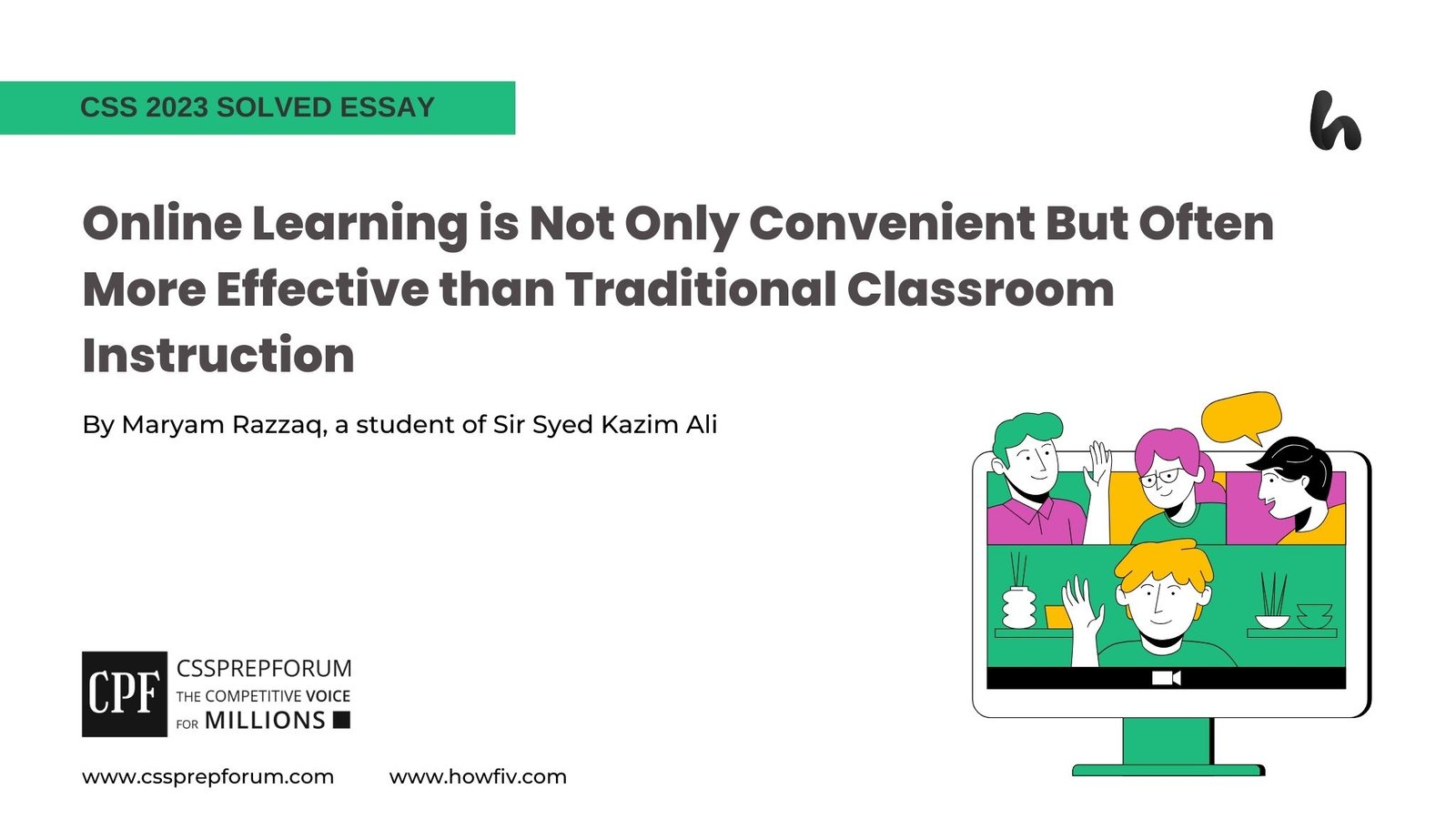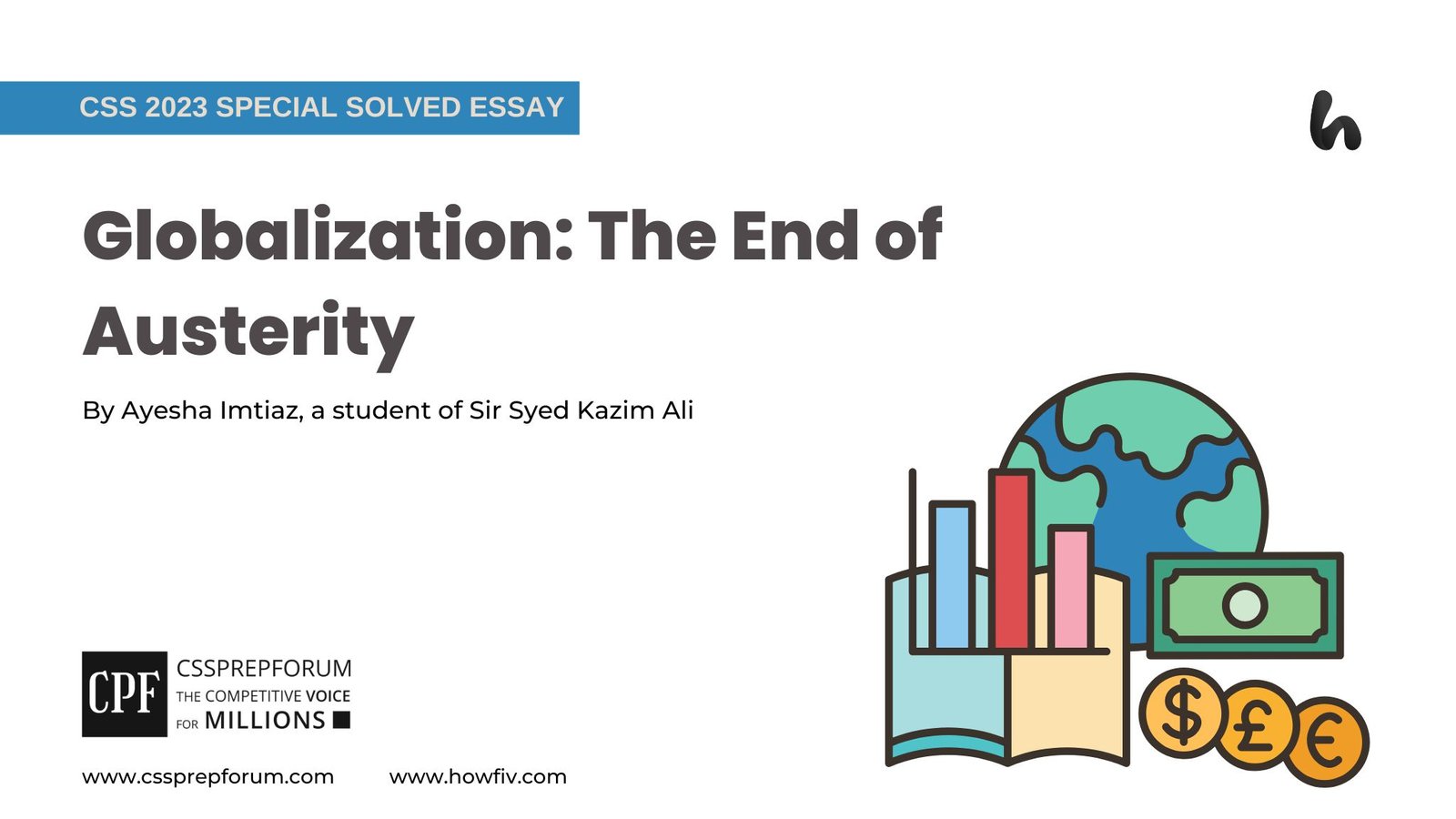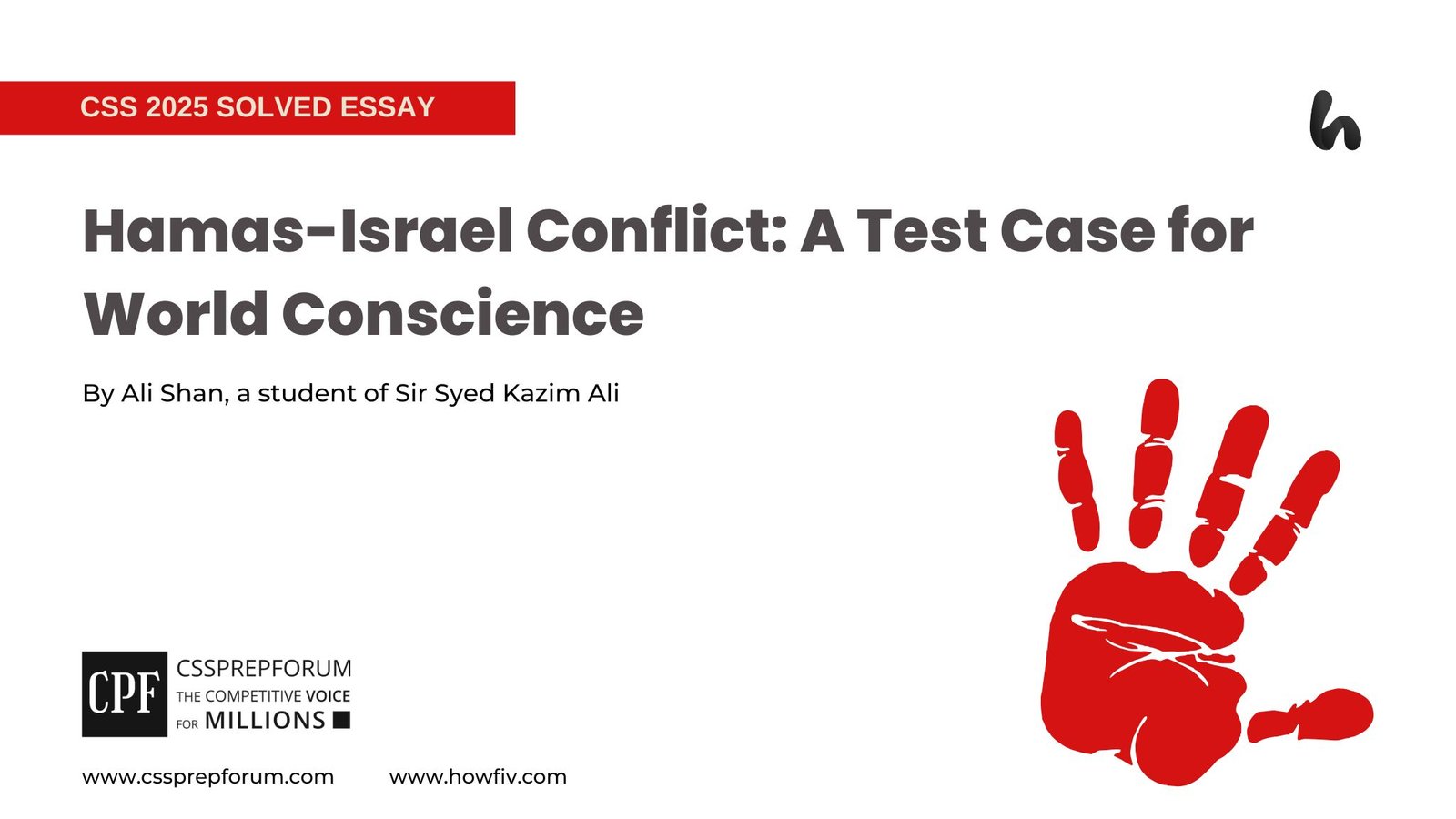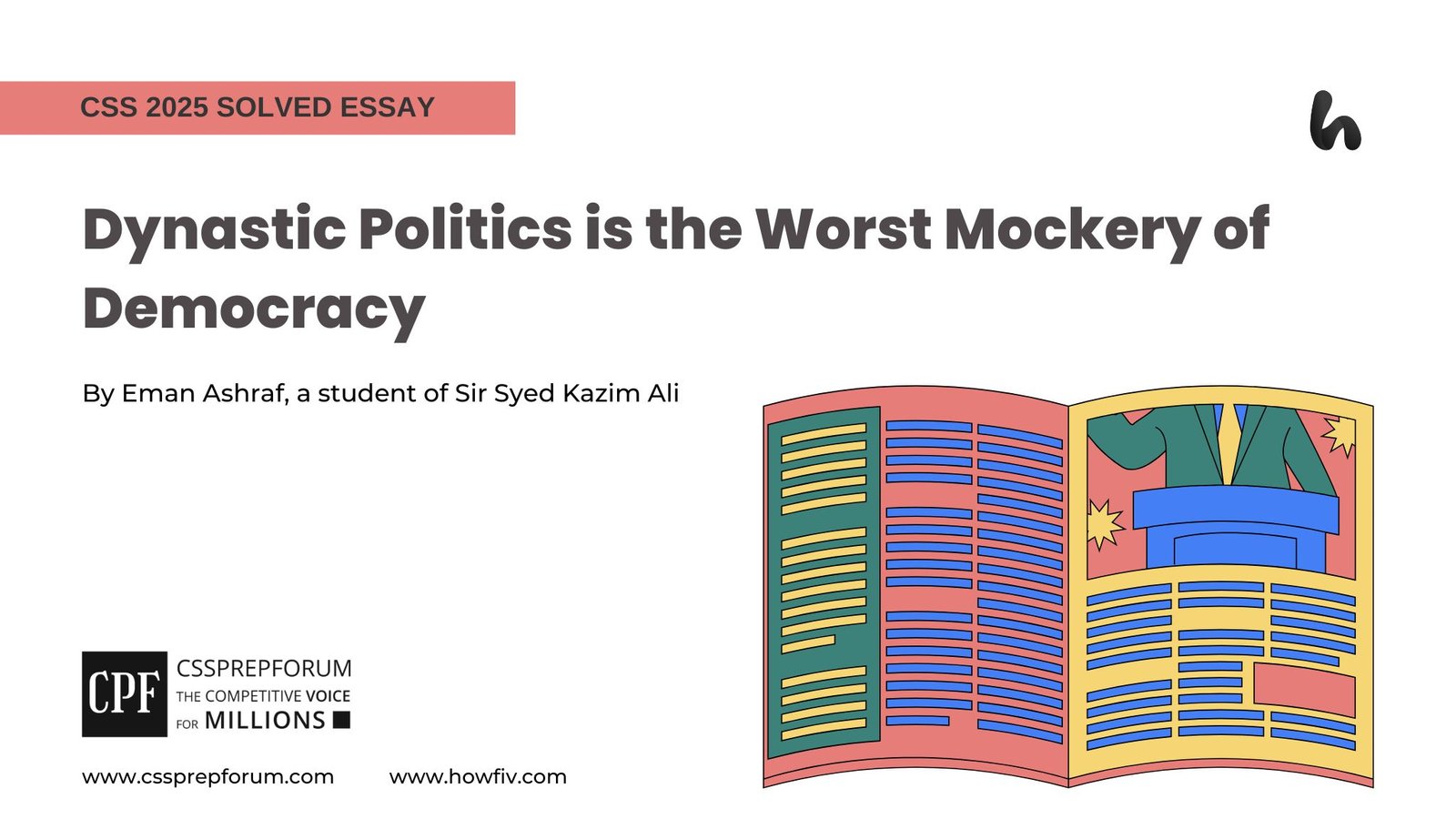CSS 2018 Solved Essay | Real Development should Transform People’s Lives, not Just Economic Statistics
Kainat Riaz, a Sir Syed Kazim Ali student, has attempted the CSS 2018 Solved Essay “Real Development should Transform People’s Lives, not Just Economic Statistics” on the given pattern, which Sir Syed Kazim Ali teaches his students. Sir Syed Kazim Ali has been Pakistan’s top English writing and CSS, PMS essay and precis coach with the highest success rate of his students. The essay is uploaded to help other competitive aspirants learn and practice essay writing techniques and patterns to qualify for the essay paper.

Outline
1-Introduction
While a strong economy has traditionally been considered a marker of development as it uplifts the status of a country globally, in the contemporary world, real development is multidimensional, including social and human development, along with economic indicators, which can transform the living standard of people by improving the quality of their life, investing in human capital to foster equitable opportunities, and promoting sustainable well-being.
2-Understanding the term real development and its link with economic growth
3-A cursory glance at the developmental process in the interdependent world
4-How does real development transform people’s lives rather than economic statistics?
- ✓Providing basic facilities to improve the living standard
- Case in point: According to the International Labour Organization (ILO), six basic needs, including health, education, food, water supply, sanitation, and housing, are identified to improve the quality of life.
- ✓Investing in human capital to develop capabilities
- Case in point: A report by the World Bank highlights that investing in people through jobs and skills helps develop human capital; as a result, it promotes growth and development by creating more inclusive societies.
- ✓Empowering people to promote gender equality
- Case in point: According to the United Nations Development Programme, achieving equal rights and opportunities for women and men and dismantling harmful gender stereotypes advance the collective action, freedom, and well-being of everyone, regardless of gender identity.
- ✓Guaranteeing the rule of law to ensure justice and accountability
- Case in point: The United Nations has underscored that the rule of law is the main factor in maintaining three pillars, including peace and security, human rights, and development, upon which its foundation stands still.
- ✓Promoting freedom to pursue goals in life
- Case in point: To Amartya Sen, freedom is central to development, and increasing freedoms is one of the most effective ways of bringing about development.
- ✓Sustaining environmental conditions to mitigate climate changes
- Case in point: According to the Organization for Economic Cooperation and Development (OECD), a rise in human development leads to better environmental sustainability by reducing ecological footprint.
- ✓Developing infrastructure to increase communication and connectivity
- Case in point: connectivity through robust transport and communication networks facilitates trade, tourism, and employment opportunities, contributing to sustainable development.
- ✓Integrating consistent and long-term policies to promote social mobility
- Case in point: According to the Human Development Report, consistent policy-making can improve growth with equity, social cohesion, private sector development, and technology development.
5-Case study
- ✓China: A glaring example of transforming the lives of citizens, together with achieving economic growth by adopting a development program
6-On what grounds do critics argue that development means to strengthen the economy?
- ✓Counter Argument: Development is an economic phenomenon because a robust economy can alleviate poverty in the country by increasing annual income and creating job opportunities.
- Refutation: Investing in human capital, central to all developments, builds human capabilities and skills essential to boosting productivity and helping people earn a livelihood, a remedy for permanently eliminating poverty from society.
- Evidence: The World Bank has emphasized that human capital development is one of the keys to reducing poverty.
- Refutation: Investing in human capital, central to all developments, builds human capabilities and skills essential to boosting productivity and helping people earn a livelihood, a remedy for permanently eliminating poverty from society.
- ✓Counter Argument: A strong economy boosts technological developments and innovations by promptly investing in research and development, a demand of the current era.
- Refutation: Imparting individuals with research and practical-based education leads to the development of critical thinking, the foundation of technological advancement and innovations.
- Evidence: To the UNDP, technological development is promoted when combined with human development because humans are the ones who develop machines and software.
- Refutation: Imparting individuals with research and practical-based education leads to the development of critical thinking, the foundation of technological advancement and innovations.
7-Critical analysis
8-Conclusion

The development process is dynamic and intricate, which sets in motion a cycle of progress and prosperity that enhances the well-being and empowerment of people within a country. While economic growth has long been synonymous with development, a more comprehensive understanding reveals that genuine development is multidimensional, with economic growth representing just one of its significant indicators. Esteemed economists such as Mahbub ul Haq and Amartya Sen have introduced a novel concept of development that encompasses human and social advancements alongside economic growth. Accordingly, with its transformative power, actual development yields many outcomes extending beyond economic growth, positively transforming lives by elevating living standards and enhancing capabilities. Providing essential amenities such as health, education, and nutrition significantly enhances the overall quality of life, propelling communities towards improvement. Conversely, critics argue that development must be solely measured regarding a nation’s economic growth, as it more effectively promotes societal progress by addressing social issues. To them, a strong economy can combat poverty through increased annual income and job creation. Nevertheless, investment in human development not only elevates workforce productivity, leading to higher per capita output but also eradicates poverty within society. As highlighted by the World Bank, human capital development nurtures the economy, playing a vital role in poverty reduction. Real development thus lies in transforming lives and ensuring individual and societal well-being rather than simply through economic statistics.
Before delving into how real development transforms people’s lives, it is imperative to understand the meaning of real development and its relationship with economic growth. Development is the constructive process of improving all human lives and capabilities quality by raising people’s levels of living, self-esteem, and freedom. For instance, according to the Human Development Report, the primary objective of development is to create an enabling environment for people to enjoy healthy, long, and creative lives beyond just economic growth. Moreover, comprehending the relationship between economic growth and development is also crucial, as often both terms are used synonymously. To contemporary scholars, development is a much broader phenomenon because it encompasses multiple domains, such as social, human, environmental, and economic indicators. And it requires maintaining a balance in all these aspects to accomplish development. Thus, economic growth is only one of the outcomes of a complex development process.
Moving toward a cursory glance at the developmental process, it helps to have a look at its current situation in the interconnected world. The digital revolution has united the world; therefore, all have worked together to overcome the interlinked global challenges, such as climate change, to expand global public goods. Even though the global Human Development Index (HDI) value has increased in recent years, this increment is highly unequal, reflecting the dismal state of development in some parts of the world. The recent Human Development report has depicted the gloomy scenario that the Organizations for Economic Cooperation and Development (OECD) of developed countries are projected to recover their 2019 values fully, but 51 per cent of the poorest countries cannot do so. For instance, the ranking of Pakistan in HDI has declined from 161 in 2019 to 164 in 2024. This report sketches the perfect picture of the current trend in development in every corner of the world.
To begin with, how real development transforms people’s lives rather than economic statistics has been justified by its several facets. First, providing basic facilities to the masses is the fundamental aim of development to enhance their living standards and lifestyles. Access to all these facilities fulfils human needs and fosters social equity and environmental sustainability in society. According to the International Labour Organization (ILO), six basic needs, including health, education, food, water supply, sanitation, and housing, are identified to improve the quality of life. Doing so creates conditions where people can live meaningful lives and pursue their goals freely, eventually leading society toward progress. So, it means that development creates an educated, healthy, and well-equipped society, paving the way for sustainable growth and prosperity.
In addition, investing in human capital is the most pertinent aspect of development as it promotes capabilities and skills in individuals. After that, human development would result in economic growth, enabling them to live decent lives. A report by the World Bank highlights that investing in people through providing jobs and imparting skills helps develop human capital, fostering growth and development by creating more inclusive societies. To Mehbub ul Haq, people are the centre of all development and the real wealth of the nation; for this reason, development is being corresponded to human development. Therefore, advancing human development enlarges people’s choices and improves their lives.
Moving down the ladder, development empowers all people equally, which instils a sense of gender equality by including females in every field of life. For instance, China and South Korea have involved women in the labour force to make them independent and promote gender equality. According to the United Nations Development Programme, “Achieving women’s and men’s equal rights and opportunities and dismantling harmful gender stereotypes advance the collective action, freedom, and well-being of everyone, regardless of gender identity.” Providing females with equal opportunities as males allows them to pursue their goals in life, ultimately uplifting their status socially and economically. Hence, development helps to uproot gender inequality in society.
Furthermore, enforcing the rule of law is a pertinent element of development to ensure justice, accountability, and the provision of fundamental rights in the country. The rule of law is necessary to build an environment that provides sustainable livelihoods to people. The United Nations has underscored the importance of the rule of law by declaring it the main factor in maintaining three pillars, including peace and security, human rights, and development, upon which the United Nations system stands still. The rule of law and development are closely linked and reinforce each other by calling for transparency, justice, and respect for humans. So, development spreads the rule of law to improve people’s living standards.
Additionally, real development expands people’s freedom zones to help them pursue their goals in life. Pursuing greater freedom enhances people’s ability to enable themselves and influence society by availing themselves of opportunities to make their own choices. To Amartya Sen, “Freedom is central to development, and increasing freedom is one of the most effective ways of bringing about development.” Providing liberty to the masses in social and political institutions develops full potential in their expertise, resulting in sustainable growth. Hence, development uplifts people’s status by providing freedom in all fields of life.
Moving ahead, real development fosters environmental sustainability to create conditions where people can live a healthy and safe life. It has been imparting awareness through education to the masses, enabling them to understand environmental changes; consequently, it enhances their capacity to protect the environment. According to the Organization for Economic Cooperation and Development (OECD), a rise in human development leads to better environmental sustainability by reducing ecological footprint, total greenhouse gas emissions, and exposure to air pollution. Understanding climate change and its consequences is crucial for mitigation measures because environmental degradation not only results in ecological imbalance but also undermines the livelihoods of humans. In short, real development contributes positively towards ensuring environmental sustainability.
Apart from the above, infrastructure development is critical in enhancing the quality of life by ensuring access to essential services and improving connectivity. Investing in infrastructure regarding energy, transport, and communication provides electricity, connects people globally, increases access to information, and supports e-commerce and digital innovation. For instance, connectivity through robust transport and communication networks facilitates trade, tourism, and employment opportunities, contributing to sustainable development. Indeed, developing resilient infrastructures, such as building stronger bridges and creating flood control systems, mitigates the impacts of natural disasters- claiming hundreds of lives every year. That is why it has made life easy and favourable for people, particularly those living in rural and remote areas. Briefly, it transforms societies by fostering social development.
Last but not least, integrating consistent and long-term policy is an innovative concept of development to endorse social mobility. Effective policy-making expands the living conditions of the masses by including their subject of interest, such as creating opportunities and distributing equal resources. According to the Human Development Report, consistent policy-making can improve growth with equity, social cohesion, private sector development, peace and security, technology development, food security, and cultural liberty. Doing so requires a legitimate government and a politically stable arena in the country that ensures the formulation and implementation of inclusive policy. Therefore, development contributes to the formulation of effective policies, ultimately transforming people’s lives positively.
Undoubtedly, the case study of China proves that development involves the transformation of people’s lives, not just the flourishment of economic growth. Adopting the Chinese development model, China has successfully gained the real meaning of development by equipping its citizens with education and health, providing equal opportunities, and promoting gender equality- eventually improving the lifestyle of its citizens- along with economic growth. According to the State Council Information Office of China, the country’s employed population has risen from 180 million to 750 million since 1949. It reveals that China does two tasks with one effort, implying that, on the one hand, equipping people with skills enhances their productivity to alleviate poverty. On the other hand, doing so has brought economic growth to the country. Thus, it proves that real development lies in changing the lives of individuals.
Nevertheless, some critics argue that development is measured only in terms of economic growth in the country because it promotes societal progress by dealing with social evils more appropriately. For example, a robust economy can alleviate poverty in the country by increasing annual income and creating job opportunities. However, investing in human capital, which is central to all developments, builds human capabilities and skills essential to boost their productivity and help them earn a livelihood, a remedy to eliminate permanent poverty from society. In its support, the World Bank and United Nations Development Programme have emphasized that human capital development flourishes the economy, which is one of the keys to reducing poverty. It suggests that human development is imperative to uplift society socially and economically. Thus, real and sustainable development is about moving society toward betterment rather than only boosting economic growth.
Moreover, it has also been claimed that a potent economy has more opportunities to advance technology and innovations, a demand of the revolutionized world, by increasing investments in research and development. For example, the United States has a lead in technology and inventions due to investing a high proportion of its GDP in science. Nonetheless, human development is crucial because higher education individuals are thought to be more productive, responsible, and innovative, leading to enhanced critical thinking- the foundation of technological changes. To support this, the United Nations Development Programme (UNDP) has highlighted that innovation and technological development are promoted when combined with human development because humans are the ones who develop machines and software. Providing the masses with practical and research-based education boosts their intellect, critical thinking, and problem-solving abilities, leading to developmental changes and innovations. Thus, human development is the real force that advances technology, not just economic growth.
Critically, development aims to provide basic facilities to people and dominate the rule of law in society, thereby improving their living standards. Moreover, it brings gender equality by providing equal opportunities to all, regardless of gender. Nonetheless, economic growth has long been considered as a sign of development. But, it is only one of the indicators of multidimensional development. Indeed, accomplishing human and social development by investing in humans and societies flourishes the economy in return. Making it true requires integrating inclusive policy to keep the balance between all dimensions to foster real development. So, development should change people’s lives apart from economic prosperity.
In conclusion, real development tops mere economic growth by encompassing a multifaceted approach that uplifts human capabilities, enhances social equity and fosters environmental sustainability. While economic indicators like GDP remain significant, true development, as conceptualized by scholars like Mahbub ul Haq and Amartya Sen, emphasizes the broader enhancement of human lives through access to education, healthcare, gender equality, and environmental stewardship. These elements improve living standards and empower individuals to participate meaningfully in societal progress. Critically, while some argue that economic growth alone drives development, evidence suggests that investing in human capital and inclusive policies are essential for sustainable poverty reduction and technological advancement. By prioritizing these dimensions, countries can achieve holistic development that raises income levels and ensures social justice and environmental resilience. Ultimately, real development is measured by its transformative impact on people’s lives, ensuring long-term prosperity and well-being beyond economic metrics alone.

CSS Solved Past Papers’ Essays
Looking for the last ten years of CSS and PMS Solved Essays and want to know how Sir Kazim’s students write and score the highest marks in the essays’ papers? Then, click on the CSS Solved Essays to start reading them.
CSS Solved Essays
CSS Solved General Science & Ability Past Papers
Want to read the last ten years’ General Science & Ability Solved Past Papers to learn how to attempt them and to score high? Let’s click on the link below to read them all freely. All past papers have been solved by Miss Iqra Ali & Dr Nishat Baloch, Pakistan’s top CSS GSA coach having the highest score of their students.











